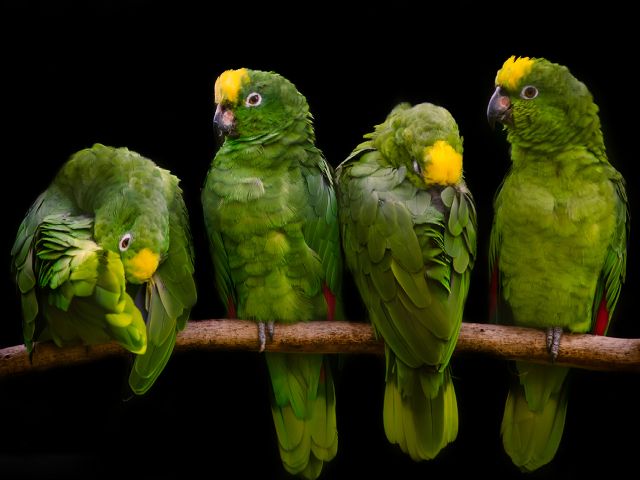The Yellow-Crowned Amazon, also sometimes known as Yellow-Fronted Amazon is derived from the Psittaciformes order of the Psittacidae family and its genus and species are Amazona and A ochrocephala, respectively. It originates from Mexico to Central and South America and lives primarily in rainforests.
The identifying features of the Yellow-Crowned Amazon include a yellow crown with bright green plumage. In addition, some of these parrots also have red and blue highlights which appear on their tails and wings. In the wild, their diet consists of seeds, fruits and nuts, berries, and blossoms.

There are at least 27 sub-species of this particular Amazon Parrot, some of which may include: the Yellow-Naped Amazon, Yellow-Crowned Amazon, Double-Yellow Headed Amazon, Blue-Fronted Amazon, White-Fronted Amazon, Red-Lored Amazon, Lilac-Crowned Amazon, to name a few.
According to aviary scientists, all of the aforementioned sub-species evolved from the Yellow-Fronted Amazon. In addition, because this specific species is not a popular bird in the commercial sense, they are less expensive and more readily available than their cousins. The Yellow Fronted Amazon utilizes tree holes for nesting and is monogamous.
The female may lay three eggs and incubate them for about 28 days. The lifespan of this particular parrot is up to 50 years and grows to an approximate size of only 13 1/2 inches from tip to tail at full maturity.
Among the many different species of Amazon Parrots, the Yellow Fronted Amazon is well-known for its ability to speak. It also should also be noted, however, that some species “talk more than others.” They are also considered to have a good temper and are generally fairly docile. They are curious, and playful, and require a great deal of love and attention.
When acquiring a Yellow Fronted Amazon, a large cage would be more suitable due to the fact that they love to stretch their wings. Due to their tendency to chew and their incredible intelligence, toys are an integral part of the Yellow Fronted’s day, particularly when they cannot be with their owner.
In addition to perches and climbing branches placed inside the Yellow Fronted’s cage, it is important to add toys that give them the ability to chew, climb, and problem-solve. There is an abundance of toys available on the market, however, not all of them are appropriate.
Toys
Many Yellow Fronted Amazons have been hurt or injured by toys that were improperly built. Optimal safety means toys that are durable, non-toxic, and free from hanging strings and other items that can get caught around a bird’s feet, legs, beak, or even neck.
Due to the fact that they live among large flocks in the wild, they are very social birds and thus they will fit right in with a family as they enjoy attentive interaction as well. The Yellow Fronted Amazon has a particularly loud screech, so acquiring a cage cover is highly recommended.
Providing a variety of safe toys is the best way to keep a Yellow Fronted occupied while you’re away, however, it is imperative your Yellow Fronted has time outside of the cage each and every day. While some of this time can be spent just hanging out with their owner, exploring, playing, and being part of the family some of the time each day is best-spent training.
Training helps curb any potentially bad behaviors and if issues do arise, training will resolve them. Socialization and training are the keys to a continuously amicable relationship with a Yellow Fronted Amazon.
When properly socialized the Yellow Fronted Amazon will be a good companion bird for a single owner or a family. They’re social, intelligent, loyal, and generally gregarious birds who do well in captivity.
